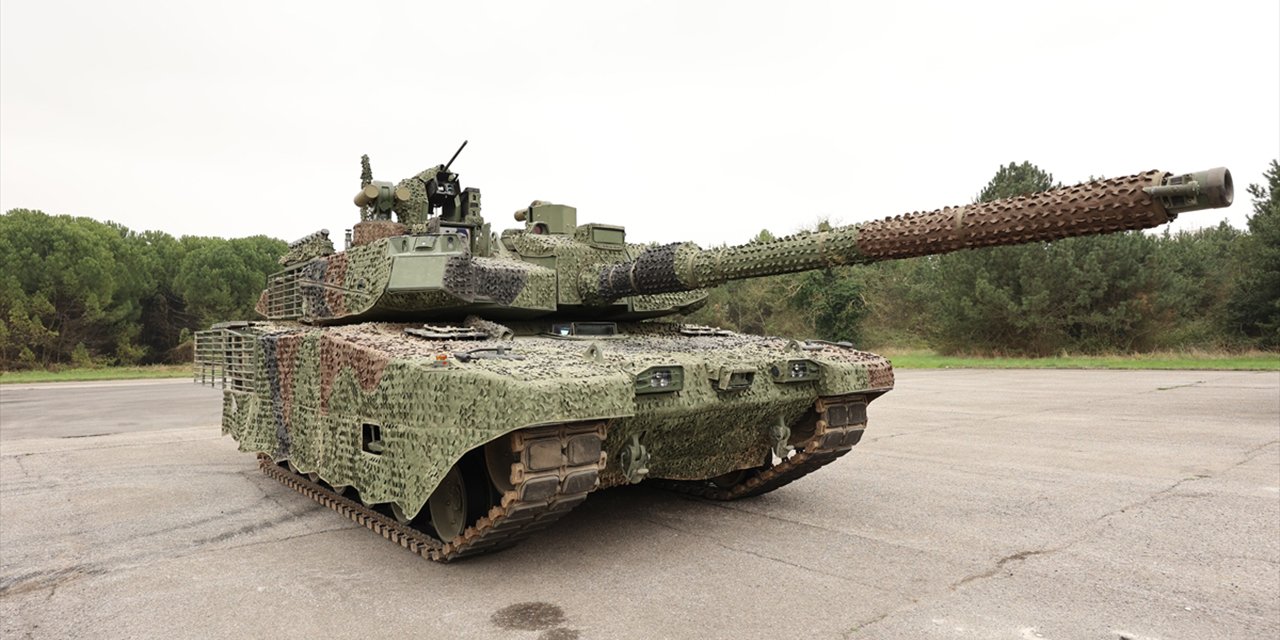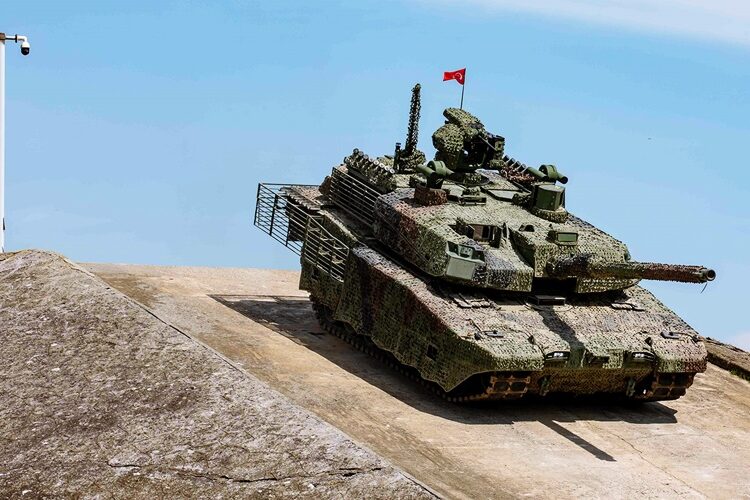Levent Kenez/Stockholm
Once hailed as a symbol of Turkey’s ambitions for a self-sufficient defense industry, the Altay main battle tank has been mired in delays, corruption scandals, favoritism and growing concerns over its relevance on future battlefields.
Initially launched in the late 2000s and envisioned to equip Turkey’s army with hundreds of domestically produced, state-of-the-art tanks, the Altay project has faced repeated setbacks. While officials publicly attribute the delays to technical issues and an alleged mistake in the choice of a production location, behind the scenes political maneuvering and infighting among businessmen close to Turkish President Recep Tayyip Erdogan have played a critical role, according to industry insiders and opposition politicians.

Fuat Tosyalı, the chairman of Turkish defense contractor BMC, which produces the tank, offered a rare glimpse into the troubles plaguing the project during an interview on April 17. Tosyalı criticized the initial choice of Karasu, a coastal town in northwestern Turkey, as an unsuitable location for tank production facilities. “It was not sustainable,” Tosyalı said, explaining that the site’s distance from Turkey’s traditional defense manufacturing hubs made it difficult to attract and retain specialized workers.
However, many experts argue that Tosyalı pushed for relocating the production site not due to strategic concerns but because the land in Karasu had gained significantly in value and he preferred to capitalize on its real estate potential rather than using it for manufacturing.
Tosyalı said BMC has since moved core production operations to Arifiye, a better-equipped military industrial zone. He emphasized that Turkey now boasts “the world’s most advanced test centers,” where imported engines from South Korea are currently undergoing rigorous trials under extreme conditions.
According to multiple defense industry sources speaking on condition of anonymity, political favoritism played a key role in the Altay saga. When the Turkish government awarded the Altay production contract to BMC, a company partly owned at the time by businessman Ethem Sancak, an outspoken Erdogan loyalist, questions immediately arose about the transparency and competitiveness of the process.
Sancak later sold his stake to Tosyalı Holding, another conglomerate with close ties to the ruling party. Observers say the transition was not smooth: Corporate infighting, disputes over land use rights in Karasu and diverging interests among shareholders slowed down decision-making at a time when the project demanded swift action.
Meanwhile, the Turkish Armed Forces’ 2018 decision to lease the critical tank palet factory in Arifiye to BMC for 25 years without a public tender further fueled accusations of cronyism. Despite generous government incentives including a $50 million investment subsidy and extensive land grants, BMC produced only a handful of prototype tanks over the next seven years.
Originally, the Altay was designed to use German technology, in particular engines from MTU Friedrichshafen GmbH and transmissions from Renk, the same suppliers behind the Leopard 2A4 tanks currently in service with the Turkish Armed Forces. Given that the Altay’s conceptual development closely mirrored the Leopard 2A4’s performance and operational philosophy, German systems were seen as a natural fit for the indigenous project.
However, there were serious delays in the project due to the German government’s undeclared arms embargo that started in reaction to Turkey’s military interventions in Syria in previous years.
Efforts to replace the German engine with a South Korean unit have introduced their own challenges. Although South Korea’s Doosan and S&T Dynamics agreed in 2023 to supply 101 powerpacks, integrating them into the tank’s design has not been seamless. Defense analysts note that swapping out engines often requires major redesigns of the tank’s hull, cooling systems and balance mechanisms, further delaying the program.

“We will initially use South Korean engines for the first Altay tanks. However, they are identical to our own designs, utilizing a modular ‘cassette’ system. As the tanks undergo maintenance in the future, we will gradually replace the imported engines with our domestically produced ones. In short, we are now manufacturing both our engines and power groups ourselves. Thankfully, we are no longer dependent on foreign suppliers,” Tosyalı initially said.
Despite official statements touting the imminent arrival of an indigenous powertrain, known as the Batu engine, experts remain skeptical. The Batu has yet to complete its 10,000-hour endurance tests, a critical milestone for operational deployment.
Lawmaker Oguz Kaan Salıcı from the main opposition Republican People’s Party (CHP) warned that without a fully Turkish-built engine, the Altay would remain operationally dependent on foreign technology. Salıcı went further, criticizing the government’s strategic planning: “In defense systems, the issue is not how ‘indigenous’ the percentage is. What matters is operational independence. If your most critical subsystem is foreign, you are at the mercy of another country’s political will.”
He also expressed deep concern that the Altay project is locked into outdated warfare doctrines. “The world has changed dramatically in the last 20 years. Conflicts like the Russia-Ukraine war have shown that traditional main battle tanks can be vulnerable to cheap drones and advanced anti-tank systems.”
Salıcı warned that by the time the Altay T2 configuration, equipped with modern survivability upgrades, enters service around 2028, the project may already be chasing obsolete concepts.
Even if production ramps up according to the current schedule — three tanks in 2025, 11 in 2026, 41 in 2027 and 30 in 2028 — questions remain about the tank’s battlefield viability.
Anıl Şahin, a defense industry researcher, voiced concern that the Altay might already be falling behind global trends. “Europe and the US are moving toward 130mm and even 140mm caliber tank guns, while Altay sticks with 120mm,” he said. He pointed out that modern warfare increasingly involves drone and loitering munition threats, against which traditional armor provides limited protection.
“Altay is a modern tank, but the very definition of a ‘tank’ is rapidly changing,” Şahin said. “We must soon start designing our own ‘future main battle tank’ concepts. Otherwise, we risk fighting tomorrow’s wars with yesterday’s weapons.”
European defense exhibitions now feature tanks equipped with 30mm secondary cannons, AESA radars and integrated drone defenses, capabilities Altay will not possess until the more advanced T2 configuration enters service, projected no earlier than 2028.
The drawn-out timeline is not merely a technical embarrassment but has significant strategic consequences. With the war in Ukraine showcasing the vulnerability of heavy armor to drones and precision-guided munitions, Turkey’s armored forces risk becoming outdated before their long-awaited modernization is even complete.
Financially, the cost implications are severe. Industry insiders estimate that development and delayed production have pushed unit costs much higher than initially projected. Integrating new engines, redesigning systems and setting up additional test centers have further inflated the budget.
The Altay tank was supposed to be a symbol of national pride and technological prowess. Instead, it has become an emblem of how political entanglements, strategic miscalculations and technological inertia can derail even the most ambitious defense projects.

As a side note, in 2016 Turkish President Erdogan had declined an offer from Koç Holding, which had already produced a prototype and was ready for mass production. Koç Holding is Turkey’s largest industrial group and is owned by a family with whom Erdogan has had a distant relationship.
In addition to production site issues, the political and financial networks surrounding BMC have also come under scrutiny. Prominent Investigative journalist Cevheri Güven, in a detailed YouTube exposé, alleged that Tosyalı is considered one of President Erdogan’s unofficial financial proxies. According to Güven, Tosyalı’s privileged access to state resources extends far beyond the Altay project.
Güven reported that Erdogan not only facilitated major defense contracts for the Tosyalı Group but also decided to appoint Fuat Tosyalı to Turkey’s Wealth Fund (TVF), an entity that controls key national assets including Turkish Airlines (THY) and major state banks.
“They transferred valuable institutions like THY and public banks into the Wealth Fund to remove them from government oversight,” Güven explained. “Then they appointed Fuat Tosyalı, a businessman receiving major public contracts, to the board of the Wealth Fund. This created a serious conflict of interest: Tosyalı, as a board member, gained influence over the very public banks from which he was seeking cheap loans.”
Güven concluded that this dual role accelerated what he described as “an unprecedented plunder” of public resources under the guise of national economic management.












